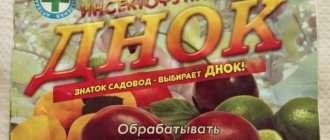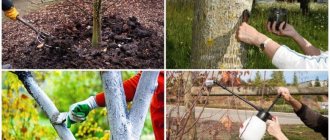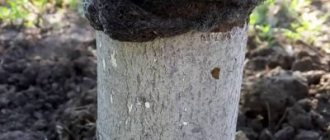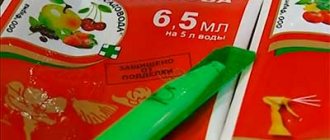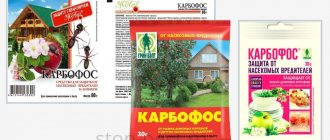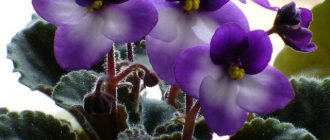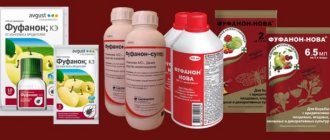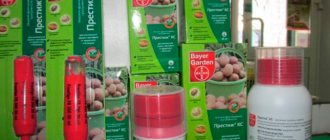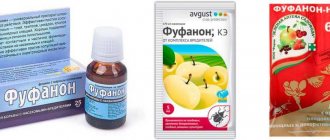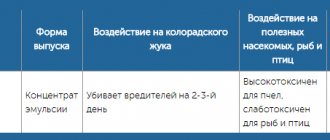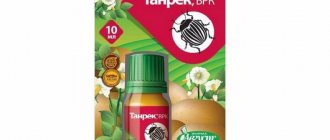Planting fruit trees is just the first step to growing them and obtaining a high-quality harvest. It is known that every plant in any garden needs care and attention. A mandatory procedure in garden care is spraying.
This event will rid the trees of insect pests, and will also help avoid many diseases. An effective prevention against diseases and pests of plantings is to treat them with special preparations - insecticides and fungicides. The most effective of them is the fungicide “Dnok”.
Reviews
The first thing that should be said about this drug: it is approved for use exclusively in industrial gardens and vineyards. The product is categorically not recommended for use in summer cottages and home viticulture.
The virtual space is teeming with user indignation directed against the owners of specialized sites that advertise the drug and contain information about how plants are treated with the Dnok fungicide. The reviews “appeal” to the conscience of manufacturers and sellers, demand that they refuse to sell the drug, since it is used to poison people, and threaten to contact the prosecutor’s office if there is no response.
According to other users, this tool can be used, but with caution. Some gardeners provide information that they learned from literature describing “Dnok”:
· the use of the product is permitted at a distance of at least 1 km from housing;
· You can use it once every 3 years.
Still others emphasize that the name “Dnok” is not included in the list of drugs for retail sale, and ask what amateur gardeners should do: should they use this product or not?
Storage rules
The fungicide can be stored only if the integrity of the packaging is maintained. The shelf life of the powder is 3 years from the date of production. The product should be stored in a dark, dry place out of reach of children.
Dnoka powder is explosive, so do not place the product near containers with flammable liquids.
How long can diluted Dnok be stored?
The shelf life of the prepared Dnoka solution does not exceed 2 hours. Therefore, the product must be used immediately after preparation. In this case, it is necessary to clearly calculate the required amount of the drug for processing, since it is impractical to prepare it for future use.
Important! During disposal, do not allow any remaining working solution to enter a body of water or running water.
"Dnok": plant treatment, instructions, reviews
There is another category of users. Many gardeners are loyal to this drug. They readily argue online that the fungicide “Dnok” is indeed very poisonous; the treatment of plants with the drug should be carried out with great care and exclusively in large farm gardens (formerly state and collective farms), which are located outside the villages. But it’s no secret that now all kinds of pests and pathogens (scale insects, false scale insects, moniliosis, clasterosporiasis, coccomycosis) have proliferated more than ever. In order to protect trees from diseases, as well as the devastating effects of pests and protect the harvest, it is necessary to use, due to its undeniable effectiveness, the fungicide “Dnok”.
Treatment of plants with this product should be carried out exclusively in industrial gardens. Fortunately, the instructions are always publicly available.
Users admit that the situation with the fungicide is rather ambiguous: on the one hand, everyone understands that it is very poisonous, on the other - what should owners of home gardens do? This poison must be used, at least periodically, by those who have no desire to lose the harvest and the trees themselves.
In general, having honestly warned fellow hobbyists about the danger, gardeners leave everyone to make their own decisions. Many are ready to share their experience of using the fungicide “Dnok” in private gardens: plant treatment, instructions, reviews are presented in exhaustive quantities. Users agree on one thing: in some cases, refusal to use the drug can lead to the certain death of the garden. There is no mention of a more effective pest control product in the reviews.
Benefits of use
It is advisable to use the drug “DNOC” due to the wide range of effects of the drug. The main advantages are:
- a large list of diseases against which the use of the product is effective;
- the drug is effective in combating most known pests, their larvae and eggs;
- it is possible to use the composition as a pesticide.
Networks recommend
For those who still dare to use it and want to know how plants are treated with the Dnok fungicide, the instructions should be carefully studied.
· Gardeners recommend covering it with plastic film before processing in order to prevent poisoning of the soil microflora. This will preserve the life of bacteria, microbes, worms and other beneficial inhabitants of the soil, stimulating the formation of humus and increasing the fertility of the soil.
· Some review authors dispute this method, due to the fact that the overwintering place for spores of many fungal diseases is the top layer of soil, and they advise replacing “Dnok” with preparation “B” or iron and copper sulfate.
· Users also mention a new drug - this is the insectoacaracid-fungicide “Brunka”, an analogue of “Dnoka”, which is approved for use on household plots and summer cottages in the CIS countries.
According to reviews, “Dnok” effectively helps against pests and tree diseases. Gardeners talk about how plants were treated using the Dnok product. How to dilute the product? We will definitely consider this, but a little later. In the meantime, let's talk about time and processing methods.
· It is necessary to mix the fungicide and “Preparation No. 30” - the mixture will not be washed off by precipitation for a long time, which is very helpful in the fight against scab and scale insects.
· “Dnok” should be used in the fall after leaf fall.
· It has been noticed that the use of nitrogen compounds when treating plants in the fall reduces their frost resistance. By using the drug in the spring, you can get the effect of abundant fertilizing with nitrogen fertilizers. At the same time, gardeners noticed that all the plant’s energy goes not to fighting pests, but to the development of foliage and shoots. Therefore, users recommend first treating plants with Fufanon or Plus Aktara ash solution. After leaf fall, treat with urea, and postpone the use of “Dnok” and “Preparation No. 30” until spring.
· It is also advised to treat fallen leaves with urea and bury them in trenches one and a half bayonets deep. With the arrival of spring, apply “Dnok” together with “Preparation No. 30”, and urea in the spring of next year.
Strong supporters of the drug
Some gardeners are categorically committed to using the drug - those who have had to endure significant crop losses from pests. They willingly share information about how plants were treated using the Dnok product. The instructions were studied very carefully. For this category of users there is no alternative to this tool. As an argument in its favor, they put forward the claim that the composition of fertilizers is much more harmful to the health of both children and adults.
Even more categorical reviews contain the authors’ conviction that no other remedy can be compared at all - they characterize its effect on pests and pathogens as eradicating. Regarding its toxicity, the authors advise those in doubt to look around and pay attention to household chemicals that are used in every bathroom and kitchen, and inquire about the composition, as well as the characteristics of the effect on the human body. The authors recommend that users carefully study the information on how plants are treated with the Dnok fungicide. The instructions (whether the product is used in the fall or spring, it doesn’t matter) contain detailed information about this process. When using a toxic drug, you should take the necessary precautions.
Acquaintance
Practice has shown that “Dnok” is one of the most effective drugs for ensuring complete protection of vineyards and fruit and berry crops from pests, diseases, fungal diseases, mites, etc. The use of a 1% concentration of the drug during the period of bud swelling does not affect the annual growth, does not have a negative effect on the condition of the leaves, does not cause the ovaries of fruits and berries to fall off. Used to treat trees and vineyards in early spring and autumn.
The start time of the drug's effect is 3-4 days after spraying. The protective effect lasts for 30 days.
Precautionary measures
This powerful product has a complex effect and requires careful handling. This applies to both granules and the finished mixture. Yellow granules are not just a source of toxic compounds - they are also explosive. According to the manufacturer's instructions, plantings should be sprayed at a distance of 1 km from pastures and residential buildings. It turns out that the drug is not suitable for a private farmstead. In practice, this rule is ignored by many.
Failure to follow safety precautions may cause health problems
Safety precautions regarding other important points come down to the use of specialized clothing, a respirator, and boots. The head should also be protected; ideally, it is better to wear a gas mask. Recommended:
- Carry out processing in calm weather.
- Avoid contact of liquid with exposed skin and mucous membranes.
- Remove people and pets from the immediate area. It is imperative to notify your dacha neighbors about the planned event.
- When the treatment is completed, do not handle dirty clothes, otherwise skin irritation will occur. It will not be possible to wash off the solution in one go.
After spraying, you must wash the sprayer thoroughly, avoiding draining it into wastewater. Also, after spraying the plants, you should take a shower. DNOC poses the greatest danger to the skin and respiratory tract. It has a significant effect on metabolism, and in some cases can lead to chronic diseases. To do this, it is enough to ingest even a minimal dose of the solution.
The shelf life of the insectofungicide is 3 g. The release date is indicated on the packaging. The bags must be placed in a dry room, away from food and containers for storing them. It is dangerous to keep them near fuels and lubricants. Even diesel and gasoline vapors can lead to unexpected consequences. The price of the interfungicide depends on the manufacturer. A 50 g package can cost 50 rubles or more.
This is interesting: the fungicide Previkur.
Chemical composition, properties
· The formula of the fungicide “Dnok” is C7H6N205.
· The active ingredient is 4,6-dinitro-o-cresol.
· It is a potent, broad-spectrum pesticide with insecticidal, fungicidal and herbicidal properties.
· Highly effective, with long-lasting action (the use of 1 spraying of trees and shrubs can provide comprehensive protection for 3 years).
· It is poorly soluble in water, so organic solvents are used to dilute it.
· Produced in cardboard-wound drums equipped with polyethylene liners. Weight – 20 kg.
· Packaged for retail sale, usually in 0.5 g bags.
· Sodium or ammonium sulfate is used as a filler for the mixture.
Operating principle
The main active ingredient of the drug is 4,6-dinitro-o-cresol. Once applied to the stems and leaves, the solution destroys the fungal infection. It also effectively fights insects, stopping the disease in its infancy.
The main active ingredient of DNOC requires careful handling due to its chemical activity
After spraying, you can observe the effect after three days. Direct introduction of infectious agents into spores occurs in the first two days. During this time, the source of infection can be neutralized, and subsequently it is completely eliminated. The lasting effect lasts for another month.
How to use fungicide "Dnok"? Instructions:
Typically, the product is used in early spring before buds open in order to resist fungal diseases and pests during the wintering phase.
For this:
· Dissolve the drug (50-100 g) in water (10 l). Water (1-2 l) is poured into a separate container. A measured portion of the chemical is dissolved in it.
· The concentrated solution is poured into the prepared water, stirring vigorously.
· Consumption recommended by the manufacturer: 10-20 kg/ha (for trees), 8-15 kg/ha (for shrubs);
· The optimal air temperature for using the drug is plus 13-20 degrees. Lower temperatures reduce its pesticide activity. A higher temperature (25-27 degrees Celsius) promotes its evaporation.
· It is not advisable to use “Dnok” in a mixture with other chemicals.
· Treating young trees in a dormant state can lead to bark burns and growth inhibition.
Advantages and disadvantages
"Dnok", like other drugs, has pros and cons. Therefore, before making a choice, you need to familiarize yourself with them in advance.
Advantages of "Dnok":
- Versatility of use.
- Wide spectrum of action.
- Economical consumption.
- Long-lasting protective effect.
- Affordable price.
The disadvantages of the fungicide include toxicity class 2, which requires increased safety measures. In addition, you cannot spray young seedlings with “Dnok”, as this leads to a slowdown in their growth and the appearance of burns on the bark.
Treatment in spring
It is recommended to treat trees using “Dnok” in early spring (before buds begin to open) or late autumn (provided there is no sap flow and the air temperature is up to 5 degrees).
In early spring, plantings suffering from heavy infestation of aphids or other pests are sprayed with 1% Dnok.
Spraying should be of a flushing nature. The above-ground parts of trees are treated especially carefully; thin branches should be carefully moistened with the working liquid - aphid eggs overwinter en masse on them.
In order to destroy red-headed aphid eggs overwintering on apple tree trunks, it is necessary to wash the trunks especially thoroughly. Spraying should be carried out using protective equipment.
Consumption rates
The product is used in volumes:
· 10 l/100 sq. m - to protect apricot, peach, cherry, plum from the wintering stages of mites, scale insects, aphids, moths, leaf rollers, copperhead, as well as from diseases: clasterosporiasis, coccomycosis, spotting, moniliosis, curl.
· 15 l/100 sq. m - to protect apple, pear, quince trees from the wintering stages of psyllids, pseudoscale insects, moths, copperheads, moths, leaf rollers, aphids, mites, scale insects, as well as diseases such as scab, moniliosis, etc.
· 8 l/100 sq. m - to protect grapes from wintering stages of pests and parasites (mites, scale insects, etc.), as well as from anthracnose, cercospora blight, oidium, spotted necrosis and other diseases.
· 15 l/100 sq. m - to protect currants and gooseberries from the wintering stages of scale insects, false scale insects, copperheads, moths, aphids, leaf rollers, scale insects, and mites. And also against powdery mildew, anthracnose, septoria, rust.
Treatment in autumn
"Dnok" is a pesticide with complex, contact-eradicative action. It provides for the simultaneous manifestation of insecticidal, acaricidal, fungicidal and herbicidal activity. Precipitation and high air humidity are favorable conditions for pests and pathogens to penetrate into the bodies of shrubs and fruit trees.
Conditions of humidity and low soil temperature contribute to the penetration of the working solution into the soil to a depth of 7 cm, where it has a pesticide effect. As the temperature rises and the soil dries out, the drug moves to the top layer.
Autumn is considered the period of effective use of the drug "Dnok". Treatment of plants in the fall involves the cessation of any operations with the soil after it has been introduced. They must be completed before using the drug.
In autumn, eradicative spraying with a 0.5-1% solution is usually carried out in the period after the leaves fall. Soil with fallen leaves is exposed to the drug in order to destroy the infectious agent contained on them.
Due to the increased toxicity of the product, it is necessary to first study all the information supplied by the manufacturer about the fungicide “Dnok” (plant treatment, instructions, safety measures, and similar information).
In autumn, as in spring, when using a chemical, you should take all necessary precautions.
Personal protective measures
When working with Dnok, it is necessary to carefully protect the skin and respiratory organs.
To do this, you should use protective clothing made of dust-proof fabric, a gas mask, gloves, and rubber boots, which are removed after pre-washing.
After spraying, you should first wash your gloves and gas mask without removing them. Do not touch protective equipment or clothing that came into contact with the drug during work with bare hands.
High guaranteed efficiency, a wide spectrum of action, ensuring an increase in the productivity of treated plants, as well as a relatively affordable price determine the uniqueness of the drug and its popularity among consumers.
Analogs
In the absence of "Dnok", you can use other chemicals that have a similar effect. Each of them must be used in accordance with the attached instructions.
- Clean Garden Nitro.
- Brunka.
- Nitrafen.
- Clean Garden.
